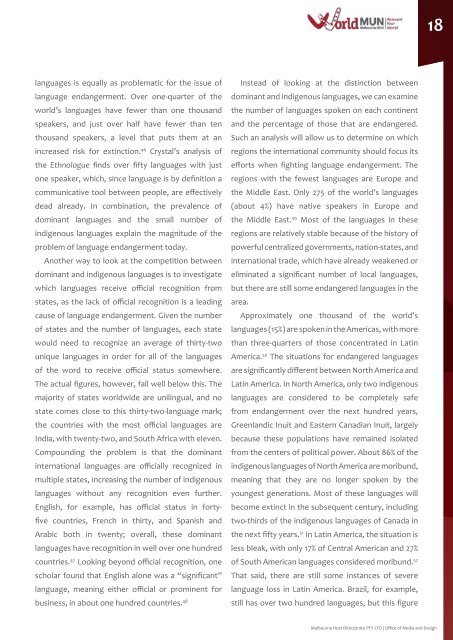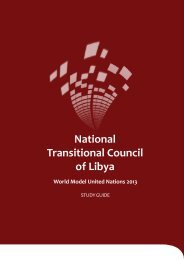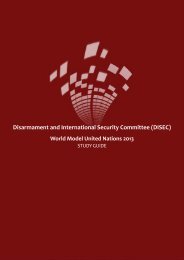Social, Humanitarian and Cultural Committee (SOCHUM)
Social, Humanitarian and Cultural Committee (SOCHUM)
Social, Humanitarian and Cultural Committee (SOCHUM)
Create successful ePaper yourself
Turn your PDF publications into a flip-book with our unique Google optimized e-Paper software.
languages is equally as problematic for the issue of<br />
language endangerment. Over one-quarter of the<br />
world’s languages have fewer than one thous<strong>and</strong><br />
speakers, <strong>and</strong> just over half have fewer than ten<br />
thous<strong>and</strong> speakers, a level that puts them at an<br />
increased risk for extinction. 46 Crystal’s analysis of<br />
the Ethnologue finds over fifty languages with just<br />
one speaker, which, since language is by definition a<br />
communicative tool between people, are effectively<br />
dead already. In combination, the prevalence of<br />
dominant languages <strong>and</strong> the small number of<br />
indigenous languages explain the magnitude of the<br />
problem of language endangerment today.<br />
Another way to look at the competition between<br />
dominant <strong>and</strong> indigenous languages is to investigate<br />
which languages receive official recognition from<br />
states, as the lack of official recognition is a leading<br />
cause of language endangerment. Given the number<br />
of states <strong>and</strong> the number of languages, each state<br />
would need to recognize an average of thirty-two<br />
unique languages in order for all of the languages<br />
of the word to receive official status somewhere.<br />
The actual figures, however, fall well below this. The<br />
majority of states worldwide are unilingual, <strong>and</strong> no<br />
state comes close to this thirty-two-language mark;<br />
the countries with the most official languages are<br />
India, with twenty-two, <strong>and</strong> South Africa with eleven.<br />
Compounding the problem is that the dominant<br />
international languages are officially recognized in<br />
multiple states, increasing the number of indigenous<br />
languages without any recognition even further.<br />
English, for example, has official status in fortyfive<br />
countries, French in thirty, <strong>and</strong> Spanish <strong>and</strong><br />
Arabic both in twenty; overall, these dominant<br />
languages have recognition in well over one hundred<br />
countries. 47 Looking beyond official recognition, one<br />
scholar found that English alone was a “significant”<br />
language, meaning either official or prominent for<br />
business, in about one hundred countries. 48<br />
Instead of looking at the distinction between<br />
dominant <strong>and</strong> indigenous languages, we can examine<br />
the number of languages spoken on each continent<br />
<strong>and</strong> the percentage of those that are endangered.<br />
Such an analysis will allow us to determine on which<br />
regions the international community should focus its<br />
efforts when fighting language endangerment. The<br />
regions with the fewest languages are europe <strong>and</strong><br />
the Middle East. Only 275 of the world’s languages<br />
(about 4%) have native speakers in Europe <strong>and</strong><br />
the Middle east. 49 Most of the languages in these<br />
regions are relatively stable because of the history of<br />
powerful centralized governments, nation-states, <strong>and</strong><br />
international trade, which have already weakened or<br />
eliminated a significant number of local languages,<br />
but there are still some endangered languages in the<br />
area.<br />
Approximately one thous<strong>and</strong> of the world’s<br />
languages (15%) are spoken in the Americas, with more<br />
than three-quarters of those concentrated in Latin<br />
America. 50 the situations for endangered languages<br />
are significantly different between North America <strong>and</strong><br />
Latin America. In North America, only two indigenous<br />
languages are considered to be completely safe<br />
from endangerment over the next hundred years,<br />
Greenl<strong>and</strong>ic inuit <strong>and</strong> eastern Canadian inuit, largely<br />
because these populations have remained isolated<br />
from the centers of political power. About 86% of the<br />
indigenous languages of North America are moribund,<br />
meaning that they are no longer spoken by the<br />
youngest generations. Most of these languages will<br />
become extinct in the subsequent century, including<br />
two-thirds of the indigenous languages of Canada in<br />
the next fifty years. 51 In Latin America, the situation is<br />
less bleak, with only 17% of Central American <strong>and</strong> 27%<br />
of South American languages considered moribund. 52<br />
That said, there are still some instances of severe<br />
language loss in Latin America. Brazil, for example,<br />
still has over two hundred languages, but this figure<br />
18<br />
Melbourne Host Directorate PTY LTD | Office of Media <strong>and</strong> Design

















